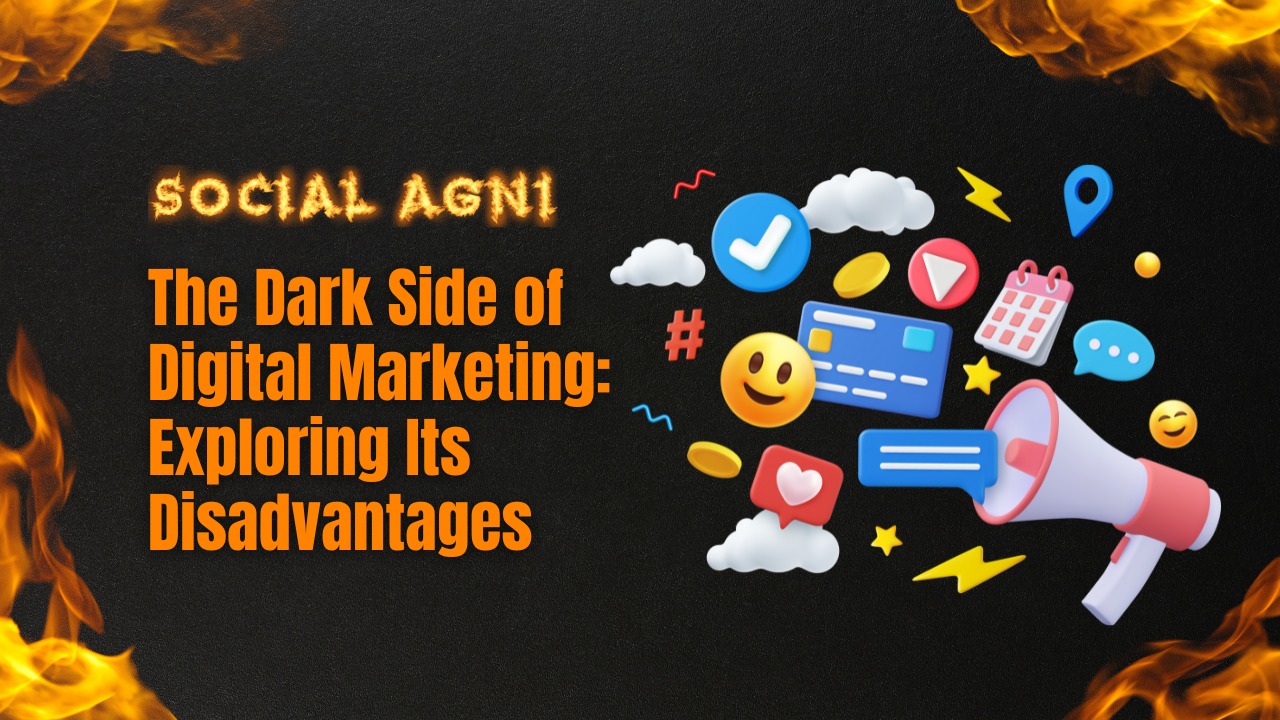Businesses today use digital marketing to reach their target audience and flourish. Digital marketing can reach a large online audience, build brand awareness, and generate leads. Digital marketing has many advantages, but its drawbacks—often overlooked—must also be considered. This essay explores digital marketing’s drawbacks to illuminate its dark side. Digital marketing has negatives, including privacy issues, data abuse, information overload, and customer fatigue. Understanding and tackling these drawbacks helps firms navigate the digital world and reduce risks. Digital marketing privacy is a major issue. Consent and data protection emerge as firms collect user data. Targeted advertising, data breaches, and identity theft can result from misusing this data. As people become aware of these hazards, they want tougher rules and transparent data practices. Digital marketers also struggle with online information overload. Marketing communications from multiple businesses might overwhelm customers. Marketers lose customers due to overexposure to ads, emails, and social media. Ad blockers and ad avoidance are another digital marketing drawback. Browser extensions and banner ad ignoring have helped consumers block bothersome adverts. This makes reaching and engaging target audiences difficult for enterprises. Digital marketing also lacks personal connection and trust-building potential. Online advertisements and brand authenticity can make it hard to build trust. Businesses must work harder to build trust and loyalty without a personal connection. Online platforms can also impact brand reputation. Negative reviews may spread quickly, damaging a brand’s reputation and financial line. Online reputation management is crucial for businesses. Digital marketing further worsens the digital divide and accessibility difficulties. Many people have internet connection, yet they may lack the means or abilities to fully participate in the digital world. This makes reaching various audiences difficult for firms and highlights the need of digital marketing inclusion. 1. Privacy Concerns and Data Misuse Consumers and companies are concerned about privacy in the digital age. Digital marketing uses personal data to target ads and customise experiences. This technique presents serious privacy and data abuse issues. Digital marketers are concerned about collecting personal data without consent. Users are ignorant of how much data firms gather and utilize. Lack of openness erodes confidence and poses data gathering ethics problems. Digital marketing also faces data abuse. If not safeguarded, names, email addresses, surfing history, and sensitive data might be stolen. Identity theft, financial fraud, and illegal account access might result. User data-targeted advertising presents privacy problems. Personalization may improve user experience but sometimes seem intrusive and exploitative. Knowing that their internet actions are continually scrutinized may make consumers feel out of control over their data. The EU’s General Data Protection Regulation (GDPR) reflects rising data privacy concerns. These policies provide individuals more control over their data and make firms accountable for appropriate data handling. Businesses must emphasize openness and consent when collecting and using personal data to address privacy concerns. Protecting sensitive data requires encryption, secure storage, and access controls. Businesses could also use privacy-by-design to include privacy into their digital marketing efforts. This includes clear privacy rules, opt-in/opt-out methods, and express consent before collecting and utilizing personal data. Businesses may build customer confidence by emphasizing privacy and using ethical data practices. Consumer privacy protects rights and boosts brand trust. Digital marketing’s biggest drawbacks are privacy and data abuse. Consumers should be concerned about the gathering and use of personal data without authorization, data breaches, and targeted advertising. Businesses must prioritize openness, consent, and data responsibility to counteract these disadvantages. They can create trust, strengthen consumer relationships, and manage the changing digital marketing landscape while preserving user privacy. 2. Information Overload and Consumer Fatigue Daily information and marketing messages overwhelm customers in the digital era. Digital marketers struggle with information overload, which may weary consumers and reduce campaign efficacy. Digital channels and platforms provide businesses several ways to contact their target audience. Brands are finding it harder to stand out in a sea of content and marketing communications. Information overload happens when people are overwhelmed with information. Thus, internet material may overwhelm, fatigue, and annoy customers. This might cause “content shock,” which desensitizes people to marketing messaging. Consumer weariness results from information overload and continual marketing. Consumers become tired of excessive advertising, emails, social media postings, and sponsored material. Ad blindness can result from weariness. Digital marketers must consider information overload and customer fatigue. Their well-crafted words may not be heard. Traditional marketing methods that interrupt and repeat might increase customer weariness and lower brand engagement. Digital marketers must focus quality over quantity to avoid information overload and customer fatigue. Some ideas: Personalization: Tailor marketing to individual requirements. Relevant content helps companies stand out and grab consumers’ attention. Targeted Segmentation: Segment the target audience by demographics, habits, and preferences. This enables more targeted and tailored messaging. Stuff Curation: Instead of bombarding consumers with stuff, curate high-quality, relevant content. This builds brand trust and credibility. Optimal Timing: Optimize marketing communication timing and frequency. Understanding customer engagement patterns helps reduce tiredness. Diversified platforms: Use many digital platforms to reach your audience. Diversify your marketing plan to reach customers where they are most engaged and responsive. User Experience: Use UX design to make digital marketing materials easy to use. User satisfaction reduces weariness and boosts engagement. Digital marketers may overcome information overload and consumer weariness by using these methods to create more meaningful and engaging customer experiences. Finally, information overload and customer tiredness hurt digital marketing. Desensitization, lower engagement, and bad brand views can result from excessive material and promotion. Businesses may overcome these hurdles and develop more meaningful audience relationships by prioritizing personalisation, targeted segmentation, content curation, appropriate timing, diverse channels, and better user experience. 3. Ad Blockers and Ad Avoidance Ad blockers and ad avoidance have become a major issue for digital marketers in an age where digital advertising is important to marketing efforts. Digital marketing initiatives are being hampered by consumers blocking web ads. Ad Blockers Software or browser extensions that block website advertisements. These programs prevent ad scripts, banners, and pop-ups to simplify and ad-free browsing. Digital marketers have a challenge
